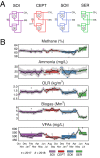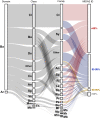Genome-resolved correlation mapping links microbial community structure to metabolic interactions driving methane production from wastewater
- PMID: 37666802
- PMCID: PMC10477309
- DOI: 10.1038/s41467-023-40907-5
Genome-resolved correlation mapping links microbial community structure to metabolic interactions driving methane production from wastewater
Abstract
Anaerobic digestion of municipal mixed sludge produces methane that can be converted into renewable natural gas. To improve economics of this microbial mediated process, metabolic interactions catalyzing biomass conversion to energy need to be identified. Here, we present a two-year time series associating microbial metabolism and physicochemistry in a full-scale wastewater treatment plant. By creating a co-occurrence network with thousands of time-resolved microbial populations from over 100 samples spanning four operating configurations, known and novel microbial consortia with potential to drive methane production were identified. Interactions between these populations were further resolved in relation to specific process configurations by mapping metagenome assembled genomes and cognate gene expression data onto the network. Prominent interactions included transcriptionally active Methanolinea methanogens and syntrophic benzoate oxidizing Syntrophorhabdus, as well as a Methanoregulaceae population and putative syntrophic acetate oxidizing bacteria affiliated with Bateroidetes (Tenuifilaceae) expressing the glycine cleavage bypass of the Wood-Ljungdahl pathway.
© 2023. Springer Nature Limited.
Conflict of interest statement
S.J.H. is a co-founder of Koonkie Inc., a bioinformatics consulting company that designs and provides scalable algorithmic and data analytics solutions in the cloud. The remaining authors declare no competing interests.
Figures




Similar articles
-
Dissecting microbial community structure and methane-producing pathways of a full-scale anaerobic reactor digesting activated sludge from wastewater treatment by metagenomic sequencing.Microb Cell Fact. 2015 Mar 14;14:33. doi: 10.1186/s12934-015-0218-4. Microb Cell Fact. 2015. PMID: 25880314 Free PMC article.
-
Syntrophic Acetate-Oxidizing Microbial Consortia Enriched from Full-Scale Mesophilic Food Waste Anaerobic Digesters Showing High Biodiversity and Functional Redundancy.mSystems. 2022 Oct 26;7(5):e0033922. doi: 10.1128/msystems.00339-22. Epub 2022 Sep 8. mSystems. 2022. PMID: 36073802 Free PMC article.
-
Upflow anaerobic sludge blanket reactor--a review.Indian J Environ Health. 2001 Apr;43(2):1-82. Indian J Environ Health. 2001. PMID: 12397675 Review.
-
Quantitative Metaproteomics Highlight the Metabolic Contributions of Uncultured Phylotypes in a Thermophilic Anaerobic Digester.Appl Environ Microbiol. 2016 Dec 30;83(2):e01955-16. doi: 10.1128/AEM.01955-16. Print 2017 Jan 15. Appl Environ Microbiol. 2016. PMID: 27815274 Free PMC article.
-
Anaerobic digestion of pulp and paper mill wastewater and sludge.Water Res. 2014 Nov 15;65:321-49. doi: 10.1016/j.watres.2014.07.022. Epub 2014 Jul 24. Water Res. 2014. PMID: 25150519 Review.
Cited by
-
Catabolism and interactions of syntrophic propionate- and acetate oxidizing microorganisms under mesophilic, high-ammonia conditions.Front Microbiol. 2024 Jun 5;15:1389257. doi: 10.3389/fmicb.2024.1389257. eCollection 2024. Front Microbiol. 2024. PMID: 38933034 Free PMC article.
-
Overcoming Extreme Ammonia Inhibition on Methanogenesis by Artificially Constructing a Synergistically Community with Acidogenic Bacteria and Hydrogenotrophic Archaea.Adv Sci (Weinh). 2025 Jun;12(23):e2502743. doi: 10.1002/advs.202502743. Epub 2025 Mar 31. Adv Sci (Weinh). 2025. PMID: 40162572 Free PMC article.
-
Limosilactobacillus Regulating Microbial Communities to Overcome the Hydrolysis Bottleneck with Efficient One-Step Co-Production of H2 and CH4.Adv Sci (Weinh). 2024 Nov;11(43):e2406119. doi: 10.1002/advs.202406119. Epub 2024 Sep 12. Adv Sci (Weinh). 2024. PMID: 39264245 Free PMC article.
References
-
- Adekunle KF, Okolie JA. A review of biochemical process of anaerobic digestion. Adv. Biosci. Biotechnol. 2015;06:205.
-
- Jimenez J, et al. Instrumentation and control of anaerobic digestion processes: a review and some research challenges. Rev. Environ. Sci. Biotechnol. 2015;14:615–648.

